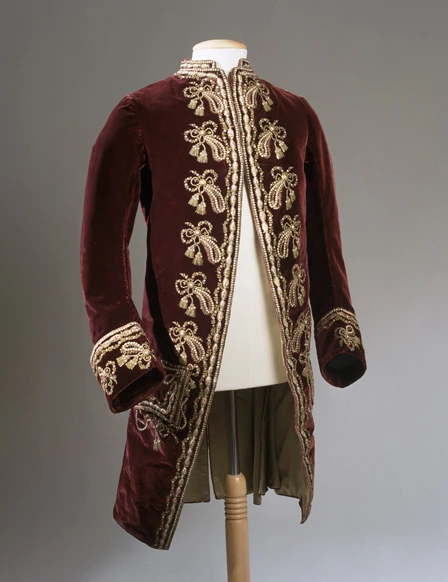Elaborate embroidered suit surviving from the 1770s
Velvet suit dating from 1770
Velvet coat embroidered with silks and gold sequins.
One of the most important piece of 18th century men's clothing in Amgueddfa Cymru's collections is a velvet suit dating from 1770. It belonged to Sir Watkin Williams-Wynn of Wynnstay, an extremely rich and well-known patron of the arts. His clothes reflected his lifestyle.
Sir Watkin Williams-Wynn
Sir Watkin Williams-Wynn (1749-1789) of Wynnstay bought elaborate velvet suits in France and Italy while making the Grand Tour in 1768-9. During the 1770s he bought clothes from many London tailors, hosiers and lace-makers, spending around £1,000 a year on suits alone - a huge sum at the time.
Gold sequins and silver thread
The plum-coloured velvet coat is embroidered with silks and gold sequins. The matching waistcoat and breeches were made at a slightly later date. The Museum also bought a fine red wool coat of similar date, decorated with silver thread embroidery.
Sir Watkin put on a considerable amount of weight as he grew older, and perhaps this is why the suit survived in such excellent condition.
Lavish embroidery
The suit coat has a cutaway front and short stand-up collar. It is lined with green silk satin to match the fabric of the waistcoat. The waistcoat has green silk satin fronts and a paler silk plain weave lining and back. Like the suit, the embroidery is of gold purl, metal sequins and floral ribbon. The work is very fine.
The suit was probably produced in a London tailor's workshop. This would have employed the best craftsmen, with a number of professional, male, embroiderers.
It is very likely that the red wool coat was made in the same workshop, as the embroidery also consists of gold and silver sequins and metal purl and silk threads, with similar motifs of bows, swags and tassels.
Grand clothes for grand occasions
Matching waistcoat and breeches
These clothes were so expensive that they could have been worn at the royal court. In Wales, Sir Watkin could have worn such clothes at his coming of age party in 1770. This was legendary in its lavishness and size, with 15,000 guests and three coaches of cooks sent from London. A hall was built especially for the occasion, later incorporated into the main building at Wynnstay, with bedrooms added on above. The food eaten at the party included some 30 cows, 50 pigs, 50 calves, 80 sheep, 18 lambs, 37 turkeys and 421 pounds of salmon. This could help explain Sir Watkin's later size! Five years later, in 1735, King George III appointed Sir Watkin to be Lord Lieutenant (the King's representative) for Merioneth.


Comments - (3)
Hi there John
I have contacted our curator and we do not have the family tree on file. However, the National Library of Wales seem to have information that might be useful for you, as the family's papers are kept there: https://archives.library.wales/index.php/wynnstay-estate-records-2
Best wishes,
Sara
Digital Team
Hi there
Thank you for your comment - I will pass on your enquiry to our curator and let you know.
Best wishes,
Sara
Digital Team
Do you have or do you know where I can obtain the Wynn
Family tree?
Kind regards,
John G Parker